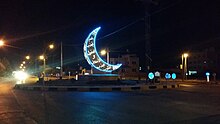Crescent


A crescent shape (/ˈkrɛsənt/, British English also /ˈkrɛzənt/[1]) is a symbol or emblem used to represent the lunar phase in the first quarter (the "sickle moon"), or by extension a symbol representing the Moon itself.
In Hinduism, Lord Shiva is often shown wearing a crescent moon on his head symbolising that the lord is the master of time and is himself timeless.
It is used as the astrological symbol for the Moon, and hence as the alchemical symbol for silver. It was also the emblem of Diana/Artemis, and hence represented virginity. In Roman Catholic Marian veneration, it is associated with the Virgin Mary.
From its use as roof finial in Ottoman era mosques, it has also become associated with Islam, and the crescent was introduced as chaplain badge for Muslim chaplains in the US military in 1993.[2]

Symbolism[]


The crescent symbol is primarily used to represent the Moon, not necessarily in a particular lunar phase. When used to represent a waxing or waning lunar phase, "crescent" or "increscent" refers to the waxing first quarter, while the symbol representing the waning final quarter is called "decrescent".
The crescent symbol was long used as a symbol of the Moon in astrology, and by extension of Silver (as the corresponding metal) in alchemy.[3] The astrological use of the symbol is attested in early Greek papyri containing horoscopes.[4] In the 2nd-century Bianchini's planisphere, the personification of the Moon is shown with a crescent attached to her headdress.[5]
Its ancient association with Ishtar/Astarte and Diana is preserved in the Moon (as symbolised by a crescent) representing the female principle (as juxtaposed with the Sun representing the male principle), and (Artemis-Diana being a virgin goddess) especially virginity and female chastity. In Roman Catholic tradition, the crescent entered Marian iconography, by the association of Mary with the Woman of the Apocalypse (described with "the moon under her feet, and on her head a crown of twelve stars" in Revelation) The most well known representation of Mary as the Woman of the Apocalypse is the Virgin of Guadalupe.
Shape[]

|

|

|

|

|

|
| Examples of lunes in planar geometry (shaded areas). Examples in the top row can be considered crescent shapes, because the lune does not contain the center of the original (right-most) circular disk. | ||


The crescent shape is a type of lune, the latter consisting of a circular disk with a portion of another disk removed from it, so that what remains is a shape enclosed by two circular arcs which intersect at two points. In a crescent, the enclosed shape does not include the center of the original disk.
The tapered regions towards the points of intersection of the two arcs are known as the "horns" of the crescent. The classical crescent shape has its horns pointing upward (and is often worn as horns when worn as a crown or diadem, e.g. in depictions of the lunar goddess, or in the headdress of Persian kings, etc.[6]
The word crescent is derived etymologically from the present participle of the Latin verb crescere "to grow", technically denoting the waxing moon (luna crescens). As seen from the northern hemisphere, the waxing Moon tends to appear with its horns pointing towards the left, and conversely the waning Moon with its horns pointing towards the right; the English word crescent may however refer to the shape regardless of its orientation, except for the technical language of blazoning used in heraldry, where the word "increscent" refers to a crescent shape with its horns to the left, and "decrescent" refers to one with its horns to the right, while the word "crescent" on its own denotes a crescent shape with horns pointing upward.[7]
The shape of the lit side of a spherical body (most notably the Moon) that appears to be less than half illuminated by the Sun as seen by the viewer appears in a different shape from what is generally termed a crescent in planar geometry: Assuming the terminator lies on a great circle, the crescent Moon will actually appear as the figure bounded by a half-ellipse and a half-circle, with the major axis of the ellipse coinciding with a diameter of the semicircle.
Unicode encodes a crescent (increscent) at U+263D (☽) and a decrescent at U+263E (☾). The Miscellaneous Symbols and Pictographs block provides variants with faces: U+1F31B